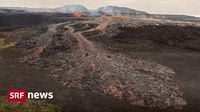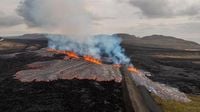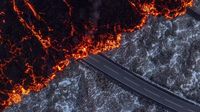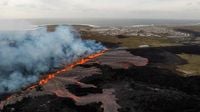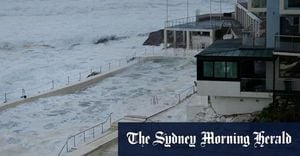On the morning of April 1, 2025, a volcanic eruption began on Iceland's Reykjanes Peninsula, just north of the fishing town of Grindavík. The eruption, which started around 9:45 AM local time, was preceded by an intense series of earthquakes that had been shaking the region for hours. According to the Icelandic Meteorological Office (IMO), the eruption occurred along the Sundhnúksgígar fissure row, a geologically active area that has seen recurrent volcanic activity since 2021.
Initial reports indicated that the fissure created by the eruption was approximately 700 meters long, but within hours it had expanded to about 1,200 meters. Lava and smoke began to rise from the ground, creating a dramatic spectacle that was captured in live broadcasts by the Icelandic broadcaster RÚV. Shortly after the first fissure opened, another crack appeared near Grindavík, prompting the Icelandic Civil Protection Authority to declare a state of emergency.
As a precaution, authorities swiftly evacuated Grindavík and the nearby Blue Lagoon, a popular geothermal spa. The evacuation was crucial as there were fears that fissures could open within the town itself. Ulfar Ludviksson, the regional police chief, noted that approximately 40 houses were still inhabited in Grindavík at the time, although most of the town's 4,000 residents had already relocated due to previous volcanic activity.
This latest eruption marks the eleventh since 2021 and the eighth since December 2023. The last eruption prior to this one began in November 2024 and lasted 18 days. The Reykjanes Peninsula had been geologically quiet for nearly 800 years before the recent series of eruptions began in March 2021, following the accumulation of magma in underground chambers.
"An eruption has begun," the IMO declared in a statement, warning residents of potential hazards. Although the lava flows typically pose little danger to people in the sparsely populated area, previous eruptions have caused damage. Notably, during a prior eruption, three houses on the edge of Grindavík were affected by lava, and the parking lot of the Blue Lagoon was also impacted during the November 2024 eruption.
In response to the ongoing volcanic activity, extensive protective walls made of earth have been constructed to safeguard infrastructure in the area. However, fears persist that lava masses could breach these barriers, particularly one located north of Grindavík. Local authorities are closely monitoring the situation, especially as the underground magma tunnel beneath the region is estimated to be around 11 kilometers long, indicating the potential for further eruptions.
Despite the evacuation orders, reports indicated that eight individuals chose to remain in Grindavík, demonstrating the resilience and determination of some residents to stay close to their homes. The Icelandic Civil Protection Authority has urged everyone to leave the area for their safety.
As the eruption continues, geologists are keeping a close eye on the developments. The Reykjanes Peninsula is characterized by fissure eruptions, which differ from traditional volcanic eruptions that produce a central cone. Instead, lava flows from long cracks in the earth, creating a spectacular yet potentially hazardous landscape.
The current eruption is significant not only for its immediate impact on local communities but also for its implications for the future of volcanic activity in the region. Experts suggest that the series of eruptions could continue for decades, as the geological processes driving this activity are complex and ongoing.
The capital city of Reykjavík, located approximately 50 kilometers away, remains largely unaffected by the eruption, and international flights at Keflavík Airport are operating normally. However, the IMO has warned that toxic gases such as sulfur dioxide could be carried by the wind into populated areas, posing health risks to residents.
Infrastructure Minister Eyjólfur Ármannsson commented on the situation, stating, "We can only wait and see how the eruption develops. We must hope that the fissure does not reach Grindavík." The ongoing volcanic activity presents a unique challenge for local authorities, who are working diligently to protect lives and property while also ensuring that residents are informed and prepared for any changes in the situation.
As the eruption unfolds, the world watches closely. The Reykjanes Peninsula, often referred to as the land of fire and ice, continues to demonstrate the raw power of nature, reminding us of the dynamic processes that shape our planet. The local community's resilience and the authorities' preparedness will be crucial in navigating the challenges posed by this spectacular yet dangerous natural event.
